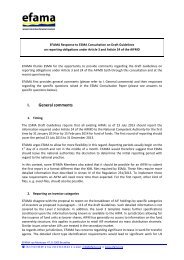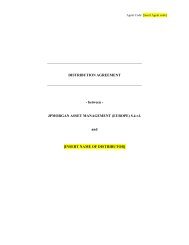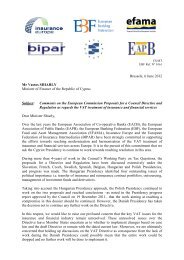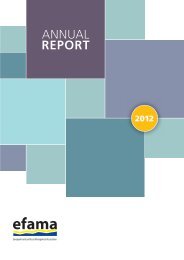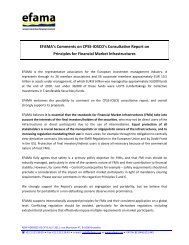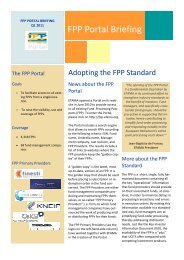EFAMA KPMG Solvency II Report
EFAMA KPMG Solvency II Report
EFAMA KPMG Solvency II Report
You also want an ePaper? Increase the reach of your titles
YUMPU automatically turns print PDFs into web optimized ePapers that Google loves.
4 WORKING GROUP FINDINGS | 39<br />
Potential Solutions<br />
Automation of the data quality process is almost mandatory if asset managers are<br />
to meet the short data delivery timelines and high quality standards. An investment<br />
in automation from the beginning in preparation for <strong>Solvency</strong> <strong>II</strong> can avoid potentially<br />
higher manual costs and incremental automation costs once the Directive is fully<br />
in place. Once <strong>Solvency</strong> <strong>II</strong> is in place, it is expected that insurers may become<br />
more demanding and benchmark against competitor asset managers or third-party<br />
administrators and automation may become a differentiator.<br />
To resolve the issue of timing conflicts, it is possible to envisage a series of pre-checks,<br />
before the net asset value (NAV) validation, that could be performed before the monthend.<br />
Once those are completed, only some final checks will remain to be performed<br />
between the month end and the date of delivery.<br />
A plan for remediation is an important step to prove to the insurer that the errors are<br />
dealt with in a systematic way. The proper channels of corrections, both short and longterm,<br />
must be identified and agreed between the insurer and the asset manager prior<br />
to the commencement of a <strong>Solvency</strong> <strong>II</strong> service provision.<br />
To achieve an interim remediation solution for data errors from data vendors, an<br />
asset manager or third party administrator may consider implementing databases<br />
that allow for temporary overwrites of information while waiting for the vendor to<br />
correct the information. This kind of overwriting capability can usually be found in data<br />
management platforms used to deal with multiple clients.<br />
A thorough description of the ownership of the data (asset manager or data vendor)<br />
provided to the insurer by the asset manager, as well as the extent of the work that<br />
is done by the asset manager on that data, would help clearly identify the limits of<br />
responsibility of the asset manager regarding data.<br />
Clearly defined contracting with the insurer on the data that must be delivered, its<br />
purpose, the level of quality, the dates of delivery and the responsibilities of each party<br />
will provide clarity over the process to be following every time an incident occurs thus<br />
preventing any unnecessary delays, expectation gaps and misunderstanding between<br />
the asset manager and the insurer client.<br />
The asset manager may provide statistical information on the data it delivers to the<br />
insurer, stating actions taken or actions to be taken to remediate errors, as well as<br />
statistics on past periods’ incidents. This serves not only to reassure the insurer at the<br />
beginning of the reporting process but also puts the data delivery quality in perspective<br />
when incidents occur.<br />
It is likely that each insurer would require their own independent assurance over data<br />
quality processes and controls, and numerous such reviews can have a signifi cant<br />
impact on business operations. It is likely that assurance reporting similar to the<br />
ISAE3000 standard will be adopted by asset managers and third party administrators<br />
to reduce the burden of these reviews. Assurance reports will attest to the data<br />
governance and data quality processes and controls on a periodic basis and, having<br />
been performed once by an independent party, the reports can then be supplied to<br />
many insurers thus reducing the impact to business operations.<br />
© 2012 <strong>KPMG</strong> LLP, a UK limited liability partnership, is a subsidiary of <strong>KPMG</strong> Europe LLP and a member fi rm of the <strong>KPMG</strong> network of independent member fi rms affi liated with <strong>KPMG</strong> International<br />
Cooperative, a Swiss entity. All rights reserved.





